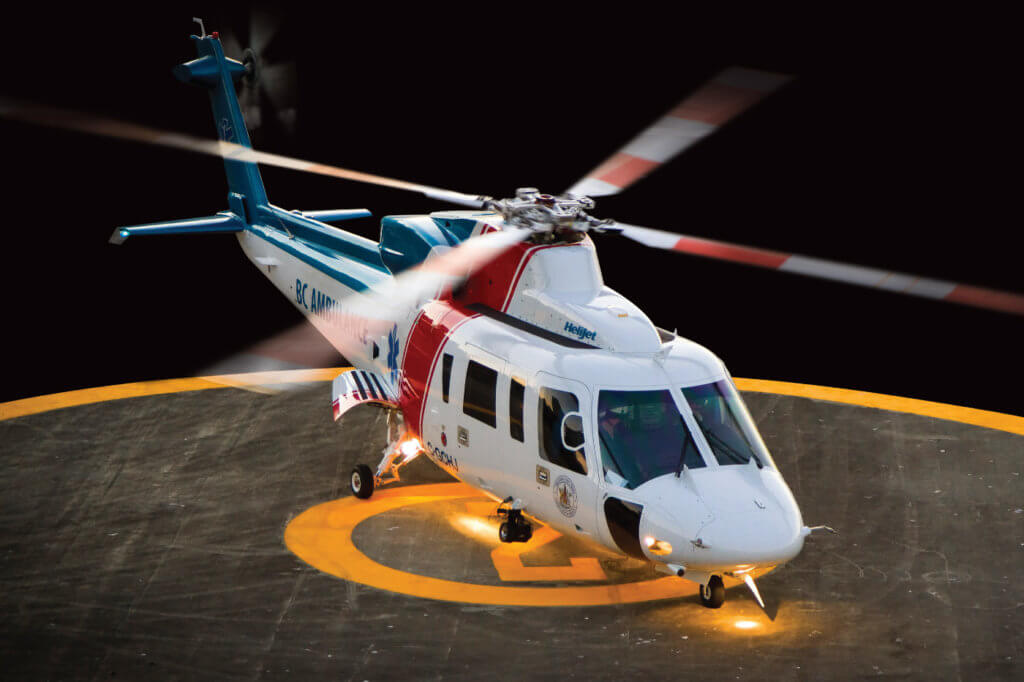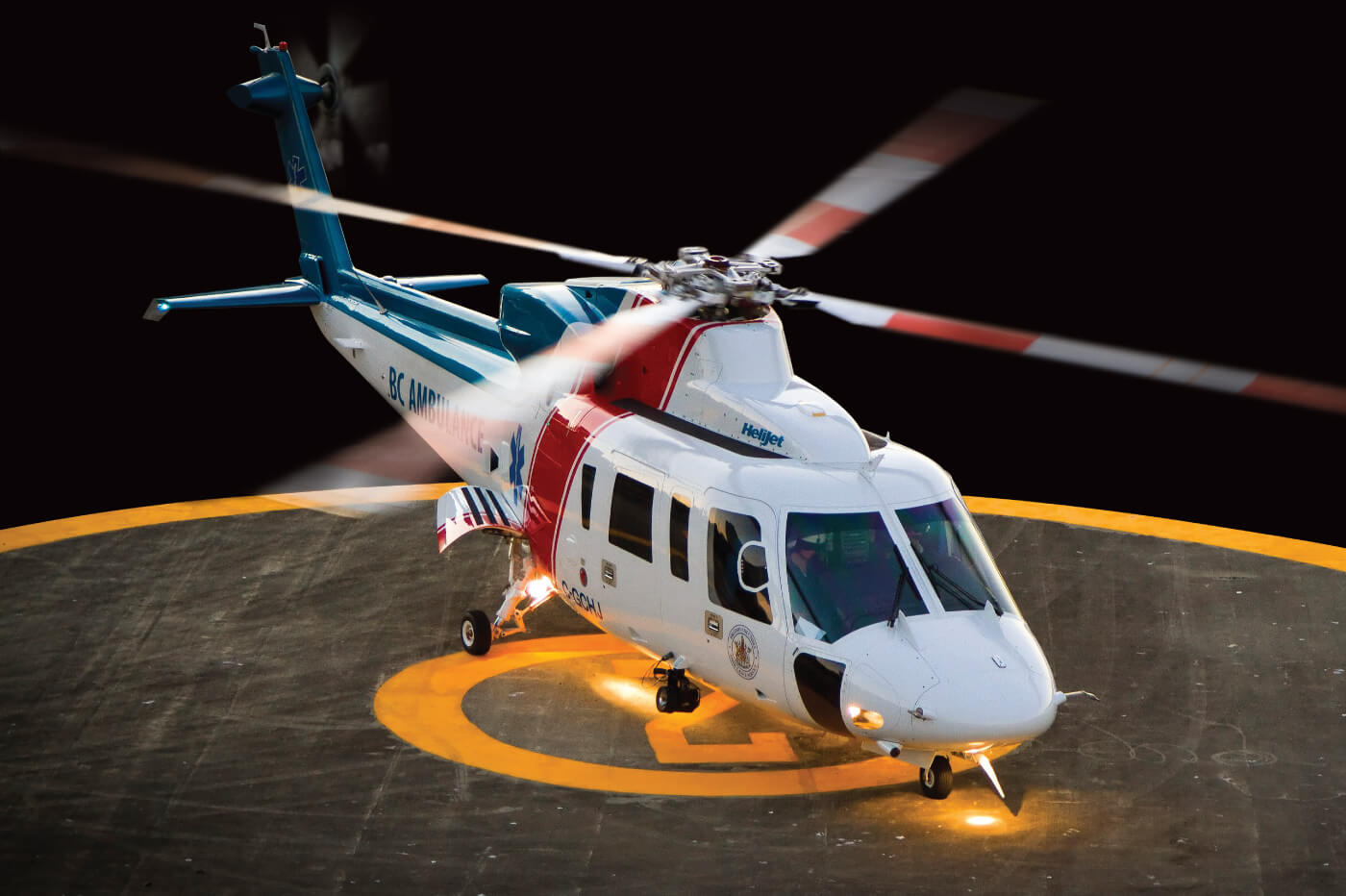Estimated reading time 6 minutes, 28 seconds.
Publicly-funded air ambulance services in Canada are being put at risk due to the national regulator’s “changing interpretation” of H1 heliport performance requirements, according to Helicopter Association of Canada president Fred Jones.

The issue came to widespread attention earlier this year after Transport Canada informed EHS LifeFlight in Nova Scotia that it could no longer land its Sikorsky S-76A (operated by Canadian Helicopters) at H1 helipads at the QEII Health Sciences Centre and IWK Health Centre in Halifax, or at the Digby General Hospital, as the aircraft didn’t meet the performance requirements for H1 heliport operation.
This was then followed by a similar decision for B.C. Emergency Health Systems’ (BCEHS’s) Helijet-operated fleet of S-76C+ aircraft, which meant flights to seven hospital helipads in the province were suspended.
As an interim measure, both organizations were forced to land their aircraft at alternate sites, and then ferry patients to hospitals by ground ambulance.
BCEHS air ambulance flights resumed at all seven helipads in mid-September following an exemption order from Transport Canada, which is in place until Jan. 31, 2017. Service was only restored to two hospital helipads–at Royal Columbian Hospital and Surrey Memorial Hospital–after BCEHS contracted Ascent Helicopters to use its MD 902 to access the facilities. In terms of a longer-term fix, BCEHS said the order would provide Helijet time to work with Transport Canada and Sikorsky to resolve outstanding regulatory requirements.
“BCEHS will continue to work with Helijet and Transport Canada to fully resolve the outstanding regulatory issues that Transport Canada has identified,” said Linda Lupini, executive vice-president of BCEHS, in a statement. “As part of our agreement, we expect Helijet to take the necessary action to fully comply with Transport Canada’s requirements, including any necessary equipment or fleet enhancements.”
The Canadian Aviation Regulations (CARs) define H1 heliports in Standard 325.19(1.a) as being located within an obstacle environment where there is no emergency landing area within 625 metres from the final approach and takeoff areas (FATO), and the helicopters using the heliport can be operated at a weight, and in such as manner that, in case of an engine failure at any time during approach or takeoff, the helicopters can either land and safely stop on the FATO or touchdown and lift-off (TLOF) area, or safely continue the flight to an appropriate landing area.
But it’s the interpretation of the performance requirements for operating from an H1 heliport that is causing a rift between operators and the regulator. CARs Standard 325.19(2.a) states:
“Helicopters permitted to use an H1 heliport shall be multi-engined and capable of remaining at least 4.5 metres (15 feet) above all obstacles within the approach/departure area in accordance with subsection 325.29(3) when operating in accordance with their aircraft flight manual with one engine inoperative.”
According to the HAC’s Jones, while these regulations have been in place since 2007, it’s only recently that Transport Canada’s interpretation of this section has become an issue.
“The way Transport Canada is currently interpreting the standard, they are applying a CAT A [Category A] requirement, which is a certification requirement for the aircraft,” he said. “But CAT A isn’t called for in [CARs] 325–it only calls for 15 feet above all obstacles, [which] is not even the CAT A performance requirement. CAT A performance calls for 35 feet above obstacles. What’s more, the aircraft flight operations manuals don’t mention H1–they only contain CAT A performance charts.”
Jones said CAT A operation also triggers a raft of associated requirements, setting a very high bar for operators.
“It’s a high bar in many ways: a high bar in terms of the helipad infrastructure; the capital cost of CAT A compliant aircraft; and a very burdensome requirement in terms of operational limitations and equipage requirements as well.”
He argued that if Transport Canada had meant to say CAT A in the standards, they should have written them that way, and said operators needed more predictability around the interpretation of the rules as they make large capital investments based on them.
“We believe it’s a problematic and uncertain interpretation and it’s certainly not clear to the industry how it’s supposed to be applied,” he said. “And when I say ‘supposed to be applied,’ I mean based on a reasonable reading of the regulations and standards–because Transport Canada seems to have adopted an interpretation that we believe may be inconsistent with [that].”
The wider impact of Transport Canada’s interpretation would be enormous, on a number of different levels, said Jones–especially due to Canada’s largely publicly-funded model of air ambulance service. “More powerful [and] more costly aircraft may put air ambulance service beyond the reach of some of the provincial ministries of health, and probably beyond the reach of small communities that would otherwise have benefitted from EMS service,” he said. “Because once you’ve started getting into those very costly aircraft, it’s difficult for the customer to support those significantly higher purchase and operating costs.”
Ultimately, Jones said the issue was about giving Canadians access to EMS helicopters. “Canadian EMS helicopter operators have a 40-year safety record that is second-to-none,” he said. “We believe strongly that Transport Canada needs to revisit its interpretation of [CARs] 325 in the context of our long-standing safety record in Canada, or the health and safety of Canadians will be negatively impacted by reductions in EMS service availability across the country.”
To help resolve the issue, HAC held a recent meeting with Transport Canada representatives and five operators to discuss the current problems and possible solutions.
“The meeting was productive because Transport Canada started to understand some of the problems the industry is facing with this and they started to understand what’s at stake, which is really getting people to lifesaving facilities and care in a safe and timely way from a serious accident,” said Jones. “So, they gained some appreciation for the dilemma that industry was facing, and we’ve agreed to talk again to discuss a reasonable way forward on this.”
When reached for comment, Transport Canada issued the following statement:
“Transport Canada has established a national policy tied to a regulatory standard on heliports that has been in place for a number of years. The department maintains its decision to require the appropriate performance and procedures necessary to comply with the current standards. It is up to the operator to select an aircraft that complies with the requirements for the intended operation. In all cases, the safety of the flight operations, the passengers, and crew remains the top priority, and the department continues to work with affected organizations regarding this matter.”
For now, Jones said the only advice HAC can give its members is to comply with the interpretation that Transport Canada has applied, and to work to identify ways to provide an equivalent level of safety with their existing aircraft.
“We are in the process of obtaining a [legal] interpretation of our own to see if the wording of [the standard] can reasonably support a requirement for full CAT A compliant aircraft,” he said.
And, while the current debate is focused on air ambulance operations, Jones emphasized the issue concerns all general aviation and commercial operations to all H1 helipads.
“Everybody has a vested interest in this,” he said. “We’re trying to work through it on a national level, because even though Canadian Helicopters and Helijet have been at the pointy end of this process, depending on how Transport Canada ultimately interprets the standard, the uncertainty will affect anyone operating multi-engine aircraft to H1 facilities.”

